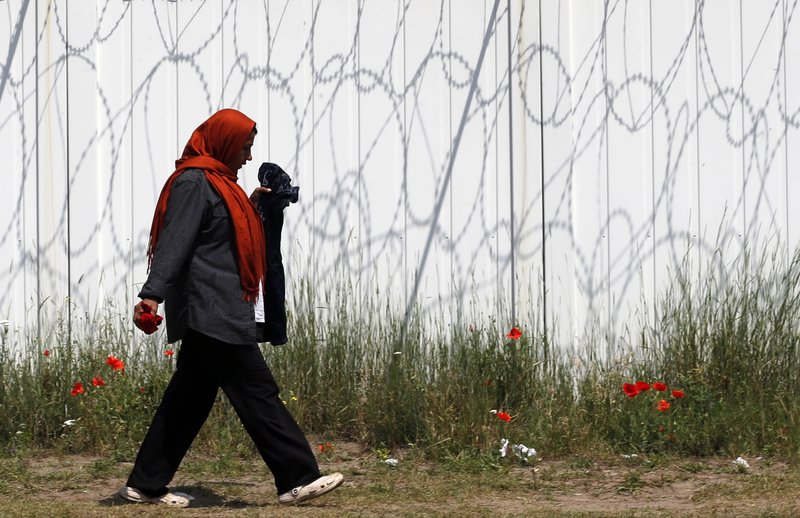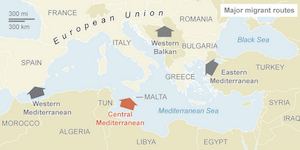HORGOS, Serbia -- The United Nations' refugee agency on Friday urged Serbia and Hungary to find a solution for the migrants camping in dire conditions at their border, hoping to enter the European Union despite border closures.
The Office of the United Nations High Commissioner for Refugees representative in Serbia, Hans Schodder, visited the small tent city that has formed at the Serbian side of the border next to the razor-wire fence that Hungary put up last year to keep the migrants away. Schodder said 300 migrants were at the camp, including families with small children and people with disabilities. He said some have been waiting for weeks without toilets or running water while relying on aid agencies for drinking water and food.
"This situation is not good at all," he said. "We hope, and we support, that the two governments will find a solution to put in place a process whereby the refugees and migrants don't have to wait in these conditions."
Hungarian authorities have been letting about 20 people a day into the country, mostly families with small children. Serbian government minister Aleksandar Vulin said authorities will try to persuade the migrants to move to nearby transit centers from where they could apply for entry into EU-member Hungary.
"This is the state border zone, it is not possible to camp here," Vulin said, adding authorities will not use force to make the migrants leave.
Migrants have been pushing to enter the EU despite the closure of the Balkan migration corridor in March and an EU-Turkey deal aimed at curbing the flow after over 1 million people came last year. Thousands have been stuck in the region for months, many seeking help from the smugglers to cross borders illegally.
The U.N. refugee agency also expressed concern Friday that migrants and refugees in Greece have been moved to several sites with "substandard conditions" after being evacuated from a makeshift camp near Greece's border town of Idomeni. UNHCR says they were taken to "derelict warehouses and factories" with "insufficient" food, water, toilets, showers or electricity -- and said it was concerned that some families were being separated during the transfer.
At the Serbian-Hungarian border, Schodder said the situation there differed from Idomeni because the border is open for small groups of people. He warned that unless a "legal pathway" for entry into Hungary is established, the refugees likely will refuse to move -- and aid workers are warning numbers of migrants could increase as the weather improves.
The largest portion of migrants has crossed into Europe from Turkey via the Aegean Sea. But a multinational NATO maritime force deployed to the Aegean has aided in reducing the flow into Europe, in large part by helping to bridge historic animosities between the two countries, the flotilla's commander said.
The seven-ship flotilla was ordered to the Aegean in February after NATO approved a joint German, Turkish and Greek proposal, with a mandate to carry out reconnaissance patrols to help the coast guards of Greece and Turkey.
Though both are NATO members, the two countries have longstanding disputes in the Aegean concerning the limits of their territorial waters and airspace, which had hampered efforts to stop smugglers bringing migrants to Europe.
They're both now contributing ships to the NATO flotilla -- with Greek ships sticking to Greek waters and Turkish ships to Turkish waters -- while the vessels from other nations, including Britain and Germany, are patrolling both.
"What we've observed here in the past few months is a clearly improved, a really visibly improved cooperation between the forces deployed here in the territorial waters," said German Rear Admiral Joerg Klein, who holds the rotating command of the force known as the Standing NATO Maritime Group 2.
"We have always had Greek and Turkish officers in the command ship. They are very professional officers who understand one another very well, work very well with each other, but naturally represent their national positions."
At some points in the Aegean, Greece and Turkey are separated by less than 2 kilometers, which made the route the most popular maritime migrant route into Europe last year, with more than 850,000 crossings, compared to about 150,000 in the central Mediterranean.
So far this year, 194,611 migrants have arrived in Europe by sea, including 156,157 by the Aegean route, according to a report Friday by the International Organization for Migration.
Despite the NATO patrols, which have been operating for about three months, the Aegean route continues to be the most popular for migrants, though numbers have been steadily declining, with 12,358 reported in April compared to 27,358 in the same month of 2015.
"Naturally, the drastic reduction of the number of migrants who are making it to the Greek islands today is above all else the success of political decisions and strategic measures, but with our mission we're also playing a part," Klein told reporters aboard the flagship FGS Bonn during a short cruise around Izmir harbor.
Information for this article was contributed by David Rising and Suzan Fraser of The Associated Press.
A Section on 05/28/2016

